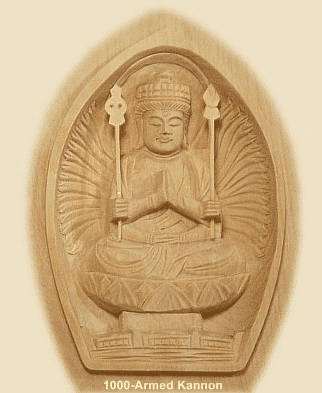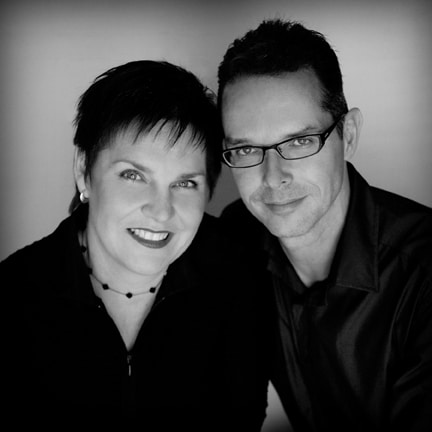
According to the Japanese teachings of the system of Reiki, one of the symbols/mantras is connected to the Japanese Deity Kannon. If we choose to work from this perspective of the Reiki teachings, then we can benefit by understanding and even embodying Kannon’s teachings.
Considering that the Thousand-Armed Kannon has one thousand arms on its one body, if the mind stops at the one holding a bow, the other nine hundred and ninety-nine will be useless. It is because the mind is not detained at one place that all the arms are useful.
As for Kannon, to what purpose would it have a thousand arms attached to one body? This form is made with the intent of pointing out to men that if their immovable wisdom is let go, even if a body have a thousand arms, everyone will be of use.
When facing a single tree, if you look at a single one of its red leaves, you will not see all the others. When the eye is not set on any one leaf, and you face the tree with nothing at all in mind, any number of leaves are visible to the eye without limit. But if a single leaf holds the eye, it will be as if the remaining leaves were not there.
One who has understood this is no different from the Kannon with a thousand arms and a thousand eyes.” ~ Takuan Sōhō
What Takuan is saying is that when we embody Kannon we free our minds, releasing ourselves from being caught in a cycle of judgement. If we do become caught, it is as if we are using just one hand of Kannon while rendering the other hands useless.
To embody Kannon’s wisdom is to have completely open and free minds, minds that never stop at any one spot, that never label what they feel or experience. This understanding affects every aspect of a Reiki practitioner’s personal and professional practice.
Interested in Kannon? Check out this information and these statues.
Bronwen and Frans Stiene are the co-founders of the International House of Reiki and co-authors of The Reiki Sourcebook, The Japanese Art of Reiki, Your Reiki Treatment, The A-Z of Reiki Pocketbook and the Reiki Techniques Card Deck. Bronwen and Frans teach in the USA, Europe and Australia. Visit the Courses page to find a course near you.


Comments 6
Lovely article. 🙂
Kannon must be one the most loved Buddhas or Bodhisattvas. Personally I have a huge affection for this Buddha.
Here are a few of the reasons:
Kannon cuts right through the genders.
In Japan he is Kannon – I think Kannon is male (please correct if I’m wrong)
In China she is Kwan Yin – female
In Tibet he is Avalokiteshvara – usually male but has a kind of female look to him. I have a lovely old metal statue of Avalokiteshvara with breasts. In his most usual form he has 4 arms. He holds 2 hands in prayer with a jewel between them. In his third had he holds mala beads. In this fourth hand he holds a lotus flower.
All versions of this Buddha focus very strongly on compassion, but Avalokiteshvara in Tibet is the Buddha in the Heart Sutra who does the teaching, the sutra really is his sutra. Avalokiteshvara focuses on compassion and wisdom together here. I feel that this is the heart of our practice.
The heart sutra explains the deepest teachings of Buddhism in few enough words to fit on one page. You could study this sutra for your whole life and it fits on one page – amazing!
Avalokiteshvara is the Buddha who looked down and saw the suffering of the world. He wept and from his tears came the 21 Taras. The Taras are female Buddhas. The most well known Taras are Green Tara and White Tara. They are well worth finding out about in their own right.
For more info on Avalokiteshvara (Kannon here) try this page:
http://www.onmarkproductions.com/html/kannon.shtml
Rebecca
x
I love Takuan’s observation about the single leaf. As the folk saying goes, when observing someone who’s so caught up in details that he fails to see the whole, “He can’t see the forest for the trees.”
Hi Rebecca and Elly,
I love Kannon as well and what he/she stand for. For me all Buddhas have female and male qualities as they come from a non-dualistic realm so to speak.
Have been working with the Heart sutra my self, so profound and also so short, amazing. I think Usui-san would have worked with this sutra as well as it is such a common sutra in Japan and used in many different practices.
That website has a wealth of information, I always come back to it.
Like Takuan’s writings, I think it is good to read these kind of teachings if we want to practice or teach the system of Reiki from a traditional Japanese viewpoint.
His book: The Unfettered Mind is a must read.
Love
Frans
Thank you Frans and Rebecca,
I loved this article and was reading last night till very late 🙂
Trying to understand , that web site is a nice encyclopedia almost ..
Came across the book as I was trying to see where the quote came from and read reviews on Amazon. Thanks Frans for the recommendation I will look at it again.
I love heart sutra when ever my mind is really confused , scared etc. listening and reciting it just lifts my troubles away seems and I feel so clear…
Thank you Frans for this article 🙂
Thanks, Frans! I’ll add The Unfettered Mind to my must-get list! I’ll never forget chanting the Heart Sutra (in Japanese, Kannon/Kwan Yin was Kanzeon) with the monks at Dai Bosatsu Zendo during two summer Reiki retreats there with Hyakuten Inamoto Sensei. The pace and the resonance and the drumming, with the monks’ voices gradually rising in volume to a shout as the chant continued and became faster and faster, was almost heart-stopping in its power. Wow. Talk about a rush! I wish I had a CD so I could crank it up and have the sound crashing all around me, followed by utter silence, as it was there. What a special, powerful experience.
Hi Elly,
Isn’t it wonderful to be in a monastery when the monks chant, so special indeed.